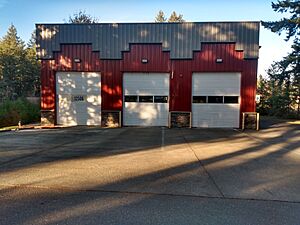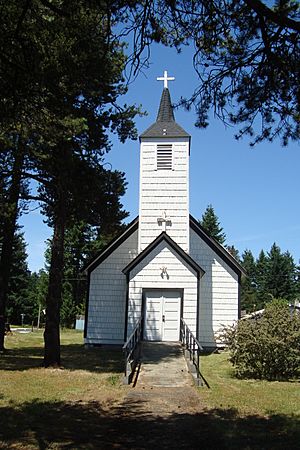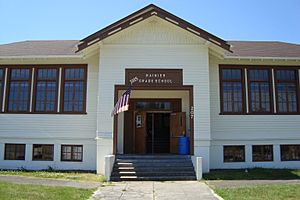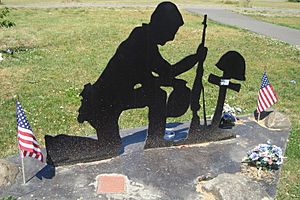Rainier, Washington facts for kids
Quick facts for kids
Rainier, Washington
|
|
|---|---|

Rainier Fire Station
|
|

Location of Rainier, Washington
|
|
| Country | United States |
| State | Washington |
| County | Thurston |
| Area | |
| • Total | 1.74 sq mi (4.50 km2) |
| • Land | 1.74 sq mi (4.50 km2) |
| • Water | 0.00 sq mi (0.00 km2) |
| Elevation | 433 ft (132 m) |
| Population
(2020)
|
|
| • Total | 2,369 |
| • Estimate
(2021)
|
2,486 |
| • Density | 1,315.88/sq mi (508.01/km2) |
| Time zone | UTC-8 (PST) |
| • Summer (DST) | UTC-7 (PDT) |
| ZIP code |
98576
|
| Area code | 360 |
| FIPS code | 53-57220 |
| GNIS feature ID | 1507707 |
Rainier (/reɪˈnɪər/ RAY-neer) is a city in Thurston County, Washington, United States. Beginning as a train stop in the 1870s, Rainier was first settled in 1890 and would become known as a logging town. The city was officially incorporated in 1947.
Contents
History
Rainier began in the 1870s as a stop on the Northern Pacific Railroad line between Kalama, Washington and Tacoma. Situated amidst the ‘ten al quelth’ prairies – Lushootseed for "the best yet" – it was named for its view of Mount Rainier. In 1890, Albert and Maria Gehrke were the first permanent settlers to homestead in Rainier; later that year a store and post office were established by Henry Harmer, who homesteaded with his wife Jessie and children on the Deschutes River near Rainier. Rainier was officially platted in 1891.
In 1896, the community's first full-time school as well as a Lutheran church were built by Albert Gehrke and his two brothers, Theodore and Paul; the buildings are now state historic landmarks.
In 1906, the Bob White Lumber Company opened, bringing prosperity to the area through logging and sawmilling. Other lumber companies, such as Deschutes, Gruber and Docherty, and Fir Tree, were soon attracted to the area as well. In the late 1920s and early 1930s, several of these mill operations and many of the local buildings were destroyed by a series of fires, leading many residents to seek work at Weyerhaeuser Lumber at nearby Vail, which is now a ghost town.
In 1936, Rainier's third school was built out of brick. The construction of this new school allowed for addition of the second story, added in 1926 of the school built in 1915 to be removed, leaving it as a single story building again.
Rainier's 1940 population was 500. In 1941, the WPA Guide to Washington described Rainier as "the social center for farmers and loggers of the vicinity, although its closed mills and vacant houses mark it as a ghost lumber town."
Rainier was officially incorporated on October 23, 1947. In 1948, Rainier opened its town hall at 102 Dakota Street South; it housed the Rainier town council, police department, and fire department.
On May 4, 1974, Rainier High School was destroyed by a fire caused by an electrical fault in an attic storage space; the state's fire marshal office had previously noted several fire hazards during inspections of the building. Classes were cancelled for the remainder of the school year; a set of 13 portable classrooms were constructed adjacent to the destroyed building by local residents and soldiers from nearby Fort Lewis. The portable buildings had been sold at cost by Seattle Public Schools after they were withdrawn from a surplus auction. A new building for Rainier High School—along with a new elementary school—was opened on September 1, 1976. In late 1979, the Town of Rainier considered leasing a portable building from Rainier School District as the existing town hall had grown too small to hold meetings in. While the school board was willing to lease the building, they were only willing to do so for a 1 year term, citing that increasing enrollment numbers could necessitate the use of the building.
In 1990, Rainier's current Town Hall was built at 102 Rochester Street West. It was assembled from several prefabricated pieces, forming the manufactured building that serves as the Town Hall.
Geography
According to the United States Census Bureau, the city has a total area of 1.73 square miles (4.48 km2), all of it land. In terms of land cover, 18% (179 acres) of the city is urban, 27% (267 acres (1.08 km2)) is forested, and 55% (540 acres (2.2 km2)) is covered with non-forest vegetation and soils.
Climate
The climate of Rainier tends to be relatively mild. Although the temperature reached a record high of 104 °F (40 °C) in 1981, the average temperature of the hottest month, August, is 76 °F (24 °C). Similarly, while the record low temperature was −8 °F (−22 °C) in 1979, the average temperature of January, the coldest month, is 32 °F (0 °C). With an average of 8.13 inches (207 mm) of precipitation, November is the wettest month. Rainier averages approximately 50 inches (1,300 mm) of precipitation a year.
Demographics
| Historical population | |||
|---|---|---|---|
| Census | Pop. | %± | |
| 1950 | 331 | — | |
| 1960 | 245 | −26.0% | |
| 1970 | 382 | 55.9% | |
| 1980 | 891 | 133.2% | |
| 1990 | 991 | 11.2% | |
| 2000 | 1,492 | 50.6% | |
| 2010 | 1,794 | 20.2% | |
| 2020 | 2,369 | 32.1% | |
| 2021 (est.) | 2,486 | 38.6% | |
| U.S. Decennial Census 2020 Census |
|||
2020 census
At the time of the 2020 census, there were 2,369 people residing in Rainier, living in 871 households. The median household income was $76,016. 14.3% of residents reported having earned a bachelor's degree or higher level of education.
The median age in Rainier was 38.4 years old, with 27.4% of the population under the age of 18, and 72.6% of residents 18 years or older. Of the 2,369 residents, 30 identified as American Indian and Alaska Native, 47 as Asian, 22 as Black or African American, 192 as Hispanic or Latino, 16 as Native Hawaiian and Pacific Islander, 1,969 as White, 60 as "some other race," and 225 as "two or more races"; 192 identified themselves as Hispanic or Latino of any race, while 1,882 identified as "Not Hispanic or Latino."
2010 census
As of the 2010 census, there were 1,794 people, 656 households, and 484 families residing in the city. The population density was 1,037.0 inhabitants per square mile (400.4/km2). There were 717 housing units at an average density of 414.5 per square mile (160.0/km2). The racial makeup of the city was 90.7% White, 1.2% African American, 1.2% Native American, 1.1% Asian, 0.1% Pacific Islander, 1.1% from other races, and 4.6% from two or more races. Hispanic or Latino of any race were 5.0% of the population.
There were 656 households, of which 40.1% had children under the age of 18 living with them, 54.1% were married couples living together, 13.4% had a female householder with no husband present, 6.3% had a male householder with no wife present, and 26.2% were non-families. 20.3% of all households were made up of individuals, and 5.6% had someone living alone who was 65 years of age or older. The average household size was 2.73 and the average family size was 3.11.
The median age in the city was 37.1 years. 26.1% of residents were under the age of 18; 7% were between the ages of 18 and 24; 28.2% were from 25 to 44; 29.2% were from 45 to 64; and 9.4% were 65 years of age or older. The gender makeup of the city was 49.7% male and 50.3% female.
Arts and culture
Art
To the northeast of downtown Rainier on a trestle support over Washington State Route 507 is a mural known as the Sgt. Justin Norton Memorial Mural. Norton, who died in 2006 during the Iraq War, was a graduate of Rainier High School. Installed in 2011, repeated vandalism of the mural had led to several repairs and re-paintings.
Festivals and events
Rainier hosts several annual events including two in August, the Rainier Roundup Days that includes a community parade and a bluegrass music festival, and the Rainier Community & Alumni Celebration honoring all past and present residents of Rainier. The community regularly hosts Relay for Life, during which, over an 18-hour time frame, participants walk around the high school track to raise money for the American Cancer Society.
Historical buildings and sites
In the early 2000s, the Rainier Historical Society, under the non-profit parent corporation of the Rainier Area Building Community, began restoring Rainier's historic schoolhouse, which was built in 1915, and converting it into a community center known as the Lifelong Learning Center. In 2005, the Rainier Food Bank was opened at the site, serving patrons on Wednesdays and Saturdays. A thrift store was also opened, with the proceeds going to fund the operational costs of the building. An art gallery and public meeting rooms followed. In November 2009, the Rainier Volunteer Library opened at the center, featuring a collection of donated books available for borrowing. A partnership with the Timberland Regional Library brought the addition of a computer kiosk and the ability to pick up reserved books from the Timberland Regional Library system at the Rainier Volunteer Library. In the fall of 2011, the food bank, under the name Rainier Emergency Food Center, relocated to a nearby church due to safety concerns at the historic schoolhouse. The building, which had been near demolition, was returned to the school district to be used for offices in 2015, its centennial year, and the library and thrift store were closed.
Parks and recreation
Rainier features eight acres of parks. In the center of town, the Veterans Memorial Park is dedicated to veterans and active military personnel, members of the fire and police departments, and various recognized volunteers and charitable groups both in the community and throughout the United States.
Nearby, Wilkowski Park is the site of the Rainier Roundup, the city's annual bluegrass music festival occurring on the fourth weekend in August. Beside the park, the Yelm–Rainier–Tenino Trail connects the cities of Yelm, Rainier, and Tenino in a paved pathway for pedestrians and cyclists.
Other parks in Rainier include Gehrke Park, Holiday Park, and Raintree Park.
Education
Rainier is served by the Rainier School District. The district consists of an elementary school, a middle school, and Rainier High School. As of the 2021–2022 school year, the district's enrollment was 925 students, taught by 56 teachers.
As of the 2021–2022 school year, Rainier Elementary School was serving 463 students from kindergarten through fifth grade. The enrollment of Rainier Middle School, which serves sixth through eighth grade, was 215 in the 2021–2022 school year, with the principal as of 2017 being John Beckman. Rainier High School included 247 students from ninth through twelfth grade in the 2021–2022 school year.
Notable people
- Linda Evans, television actress
- Chad Forcier, two-time NBA champion assistant coach
- Eloy Pérez, WBO and NABO super featherweight champion
- Billie Rogers, jazz trumpeter and singer
See also
 In Spanish: Rainier (Washington) para niños
In Spanish: Rainier (Washington) para niños





